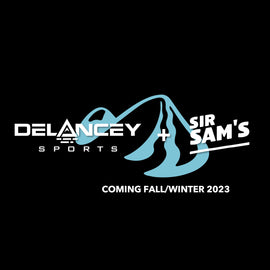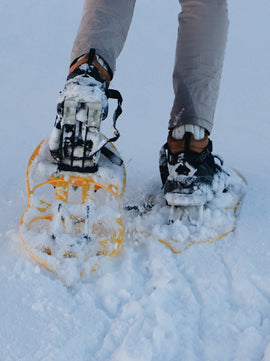However you call it - cross country, XC, or nordic skiing - Haliburton is home to some of the best trails in Ontario. With 188km of groomed trails, there is something everyone can explore and enjoy.
Nordic skiing is a tough sport - it is up to your muscles and lungs to get you moving! It can be insanely difficult. It is a leg day and an arms day and a core and cardio workout, all in one. It's no wonder so many people love the sport.
Here in Haliburton, the Haliburton Highlands Nordic Trail and Ski Club Association grooms and maintains a three trail system: Glebe Park, Moosewoods, and Twin Lakes. There are also more options to explore with Haliburton's Provincial Parks (and more!) here is a handy list to reference.
To embark on your next Nordic adventure, you'll need the right skiing equipment. Here is our guide to get you started.
Skis
The most critical piece of nordic skiing equipment are the skis. Nordic skis are designed for a gliding motion, making them longer and narrower than downhill skis. They come in various styles.
Classic Skis: These are the traditional skis, equipped with a grip zone (wax or fish scales) underfoot to provide grip on the snow. Classic skiing allows for a more controlled and stable stride.
Skate Skis: Skate skiing involves a motion similar to ice skating, where skiers push off to the side. Skate skis are shorter and don't have grip zones; instead, they rely on a smooth glide, making them ideal for groomed trails and well-established tracks.
Backcountry Skis: For those who prefer unmarked trails, backcountry skis offer a wider, more versatile design. These skis typically feature metal edges for improved control on varying terrains.
Once you determine what type of skiing you would like to do, you need to be fitted to the right size. In order to do so, here are some guidelines.
Consider your body weight and height. The most critical factor in choosing the correct ski length is your body weight and height. Skis are designed to provide proper flex and grip based on your body composition.
Match your body composition to what type of skiing you will be doing. For classic skiing, you'll want skis that are approximately your height - the basic formula is your height + 15-30cm. This allows for better control and grip when using the classic diagonal stride technique. Some skiers prefer skis slightly longer or shorter depending on their personal preference and weight, with a heavier weight being a longer ski.
Skate skis are shorter than classic skis and are designed for a different skiing technique that mimics ice skating. Skate ski length is often based on the skier's weight, with shorter skis for lighter individuals and longer skis for heavier individuals.
Consider Terrain and Snow Conditions. For groomed trails it's best to stick with skis that are near your weight range. These skis are optimized for well-established tracks. For backcountry skiing - i.e. you plan to explore off-trail and unmarked terrain - consider slightly longer skis for added stability and float in deep snow.
Flex. The ski's flex is also important and is designed to match the skier's weight. Heavier skiers may need stiffer skis, while lighter skiers should opt for softer flex. The ski's flex affects both grip and glide.
Trial and Error. While these guidelines can help you make an informed decision, skiing preference can be somewhat subjective. Some skiers prefer slightly longer or shorter skis for various reasons. If possible, try out different ski lengths to see what feels most comfortable and efficient for you.
Ski Boots
To complement your choice of skis, you'll need a pair of nordic ski boots. These boots should offer comfort and support for your feet and ankles, ensuring an efficient transfer of power to the skis. Like skis, there are two main types of cross country ski boots:
Classic Boots: Classic boots are designed for control and precision in classic skiing techniques. They have a more flexible sole, allowing for a natural, diagonal stride.
Skate Boots: Skate boots feature a stiffer sole to provide lateral support for the skate skiing motion. This added rigidity is necessary for efficient power transfer during each skate.
Proper fit is super important for ski boots. Ensure that they are snug but not too tight, with enough room to wiggle your toes. Always try on boots with the socks you intend to wear while skiing.
Bindings
Bindings are the crucial link between your boots and skis. They come in two main styles: NNN (New Nordic Norm) and SNS (Salomon Nordic System). Ensure that your boots and skis have compatible binding systems, and adjust the bindings to your skiing style and ability.
Poles
Nordic skiing poles are an essential part of the equipment, assisting you with balance, propulsion, and maneuvering. The ideal pole length depends on your skiing style. Classic skiing, choose poles that reach your armpits while standing. Skate skiing poles should be longer, up to your chin, to provide better stability and push-off power. Backcountry Skiing may require longer and more durable poles for varied terrain.
Clothing and Accessories
To stay comfortable and safe during your nordic skiing adventures, you'll need appropriate clothing and accessories. Here are some essentials:
Layered Clothing: Dress in moisture-wicking and insulating layers to stay warm and dry. You will be battling the elements while also sweating up a storm!
Hand Protection: Protect your hands from the cold, and consider having gloves that grip (for your poles).
Headgear: A hat or headband will help you prevent heat loss.
Goggles or Sunglasses: Shield your eyes from snow and glare.
Backpack: Carry essentials such as water, snacks, a first-aid kit, and navigation tools.
At Delancey Sports, we carry nordic specific clothing and accessories by Craft. These pieces help you stay warm, and are moister wicking to keep you dry.
Conclusion
Nordic skiing equipment is the key to unlocking the beauty and thrill of winter landscapes. With the right skis, boots, poles, and clothing, you can explore the snowy wilderness, stay fit, and create lasting memories. Whether you're a beginner or an experienced skier, carefully selecting the right gear will ensure you have a fantastic and safe nordic experience. So, prepare your equipment, embrace the winter wonderland, and enjoy the exhilarating world of nordic skiing.


